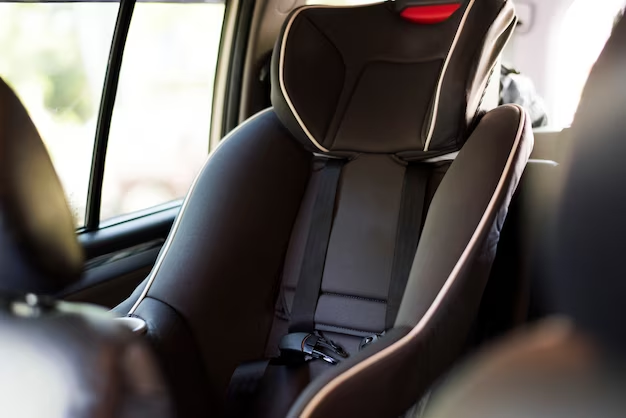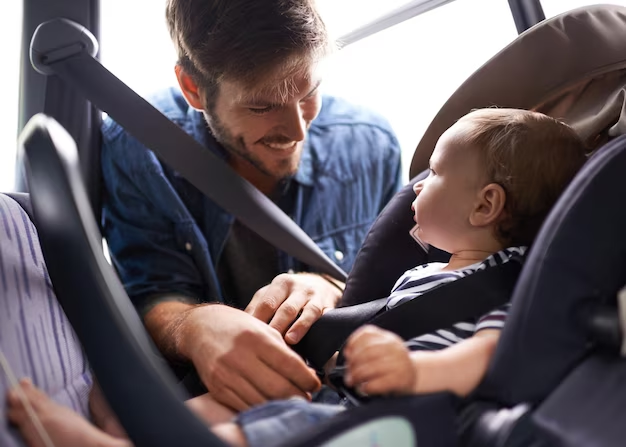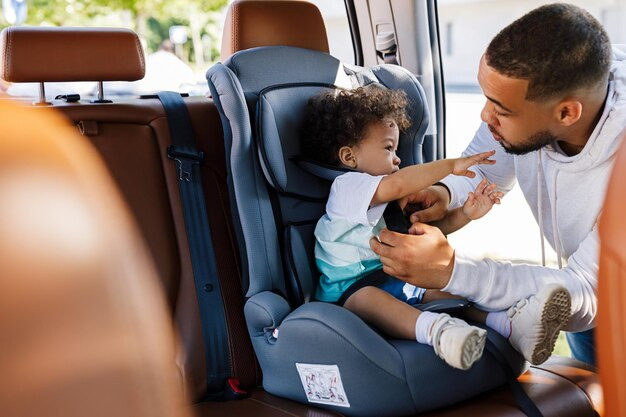The Aloha State is dedicated to the well-being of its youngest visitors just as much as it is to the beauty of its natural scenery. Following Hawaii’s booster seat law is essential for the safety of children on the road and is also mandated by law. To ensure that families are in compliance with these crucial safety laws, this article explores the intricacies of the Hawaii booster seat law, providing valuable insights and information.
A Guide to Hawaii’s Booster Seat Law

A critical component of kid passenger safety in Hawaii is the booster seat law. It specifies how booster seats must be used when children are transported in motor vehicles. In the event of an accident, these laws are put in place to make sure that young passengers are even safer and less likely to get hurt.
Key Requirements of the Booster Seat Law in Hawaii:
Booster seat safety is a top priority in Hawaii, which is why the state passed a law mandating their use. Age, weight, booster seat placement, and required booster seat types are all spelled out in detail. Presented below is comprehensive data regarding these essential needs.
Age and Weight Guidelines
The Hawaii booster seat law divides children into various weight and age categories to establish the necessary safety precautions for each:
- Children under the age of four: Traveling with a child less than four years old requires the use of a child safety seat. Babies and toddlers may relax well in this ergonomically engineered seat.
- Children aged four through seven: The usage of a child safety seat or booster seat is required by law for children aged four to seven. Be that as it may, there are outliers. For children who are over 40 pounds or who are taller than 4’9″ a booster seat is not necessary. Because of this adaptability, larger and older children can wear standard seat belts when the time comes.
Positioning of the Booster Seat
Hawaii law mandates the following placement of booster seats to ensure the safety of children:
- The vehicle’s back seats are the only acceptable locations for booster seats. When the car has front-seat airbags, this is an absolutely necessary requirement. Putting a youngster in the front seat when the airbag is deployed increases the risk of serious injury or death.
Type of Booster Seats
The booster seat law in Hawaii acknowledges the variety of seats on the market and stresses the significance of choosing the correct one according to the child’s weight, height, and age. Booster seats often come in the following styles:
- High-Back Booster Seats: Child safety seats with a high back support the child’s neck and head for more comfort and protection.
- Backless Booster Seats: Children who are able to sit up straight without the need for extra head support are the ideal candidates for backless booster seats.
Importance of Compliance
There are a number of reasons why everyone living in Hawaii should be familiar with and obey the booster seat law:
- Safety: The fundamental and most important justification for these rules is to ensure the protection of children. In order to lower the likelihood of injury in the case of an accident, booster seats are designed to raise youngsters to a level where the car seat belt fits them correctly. When children are properly fastened in car seats, they are less likely to be seriously injured or even killed in the event of an accident.
- Legal Requirements: Penalties and fines may result from violating Hawaii’s booster seat law. The severity of these regulations is demonstrated by these sanctions, which also act as a powerful incentive to comply. It is important for parents and guardians to be informed about the possible legal ramifications of failing to use booster seats as mandated.
- Setting an Example: Parental and guardian compliance with the booster seat regulation demonstrates to youngsters the value of a safe driving environment. Proper use of booster seats exemplifies responsible and safe driving skills, which children learn from seeing their parents. A child’s perspective on road safety can be profoundly influenced by this formative teaching.
How to Choose the Right Booster Seat

Choosing the correct booster seat is an important part of following Hawaii’s booster seat law. A few pointers to assist you in making a decision:
Check the Weight and Height Limits
The maximum user weight and height are important specifications to look for in a booster seat. The following is an analysis of this vital component:
- Weight Limits: The maximum weight that a booster seat can accommodate is often between thirty and one hundred twenty pounds. The weight of your child should be considered when selecting a booster seat. Check the seat’s weight limit to make sure your youngster fits. Doing so ensures the seat can safely confine and protect the child.
- Height Limits: Booster seats include height limitations in addition to weight limitations. Make sure your child’s booster seat accommodates their height so the seatbelt fits securely. For optimal safety, make sure the seatbelt crosses your lap and chest rather than your neck or belly.
- Future Growth: Choose a booster seat with enough room to spare so it may grow with your child. To accommodate your child’s growing size, you can get booster chairs with adjustable features. If you acquire a seat that can grow with your child, you won’t have to buy another one when they outgrow it.
Look for Certification
Make sure the booster seat is certified for usage in motor vehicles to ensure its safety and quality. Keep an eye out for these certification requirements:
- Federal Motor Vehicle Safety Standard (FMVSS) 213: In this federal regulation, the safety standards for child restraint systems are laid out. Verify that the booster seat meets the minimal safety requirements specified by FMVSS 213.
- National Highway Traffic Safety Administration (NHTSA) Certification: A number of booster seats have received certification from the National Highway Traffic Safety Administration (NHTSA), which rates and details their safety performance. If you want to be extra sure that the booster seat is safe, look for one with a high NHTSA rating.
Consider the Type
There are two primary varieties of booster seats, and each has its own set of benefits and is best suited to certain vehicles:
- High-Back Booster Seat: An extra layer of protection for a growing child’s neck and head can be found in a high-back booster seat. If your car doesn’t have a headrest, these will help keep your child’s head in a safe position. For your extra comfort, these seats often have adjustable features.
- Backless Booster Seat: For cars with headrests or high seatbacks, a backless booster seat is the way to go. They take up less room and are sometimes easier to transfer between cars. On the other hand, high-back booster seats provide more support for the neck and head.
Installation and Usage Tips
To get the most out of the booster seat in terms of safety, make sure to install and use it correctly:
Read the Manual
It is critical to read both the booster seat’s instructions and the owner’s handbook of your vehicle carefully before installing and using the booster seat. Important and detailed instructions for installation and use are provided in these manuals. Before you install anything, make sure you read and follow all of the manufacturer’s instructions carefully.
Secure the Seat
Properly securing the booster seat within your vehicle is a critical step in ensuring its effectiveness. Follow these steps for secure installation:
- Use the Vehicle’s Seat Belt: In most cases, booster seats are secured using the vehicle’s seat belt. Ensure that you route the seat belt correctly through the designated paths on the booster seat, following the manufacturer’s instructions. Make sure the seat belt is not twisted or tangled.
- Utilize the LATCH System (if applicable): Some booster seats come equipped with LATCH (Lower Anchors and Tethers for Children) connectors, primarily designed for child safety seats. If your booster seat includes LATCH connectors and your vehicle has LATCH anchor points, use this system as an alternative to the seat belt for installation. Refer to both the booster seat and vehicle manuals for guidance on LATCH system installation.
- Check for Secure Attachment: After securing the booster seat using either the seat belt or LATCH system, ensure that the seat is tightly and securely fastened to the vehicle’s seat. Attempt to wiggle or move the booster seat to confirm that it is stable and does not shift.
Positioning the Child
Proper positioning of the child within the booster seat is crucial for their safety and comfort. Follow these guidelines for correct child placement:
- Seating Back and Hips Against the Backrest: Instruct the child to sit all the way back in the booster seat, ensuring that their back and hips are firmly against the backrest of the seat. This provides support and helps maintain proper alignment during the journey.
- Seat Belt Across Thighs, Not Stomach: Adjust the seat belt so that it snugly fits across the child’s thighs, just above the hips. Avoid having the seat belt rest on the stomach area, as this can lead to abdominal injuries in the event of a collision.
- Shoulder Belt Across the Middle of the Shoulder: The shoulder belt should be positioned comfortably across the middle of the child’s shoulder. It should not be too close to the neck or too low on the arm. The proper placement of the shoulder belt ensures that it provides effective restraint and minimizes the risk of injury.
Conclusion
Adhering to the booster seat law in Hawaii is a crucial aspect of ensuring child-passenger safety. By understanding and complying with these regulations, you contribute to a safer driving environment for your children and other road users. Remember, when it comes to our keiki (children), their safety is always the top priority. Let’s embrace the spirit of aloha and keep our young ones safe on Hawaii’s roads.
FAQ
Q1. At what age can a child stop using a booster seat in Hawaii?
A child can stop using a booster seat when they reach the age of 8, are taller than 4’9″, or weigh more than 40 pounds.
Q2. Are there any exceptions to the booster seat law in Hawaii?
Yes, exceptions include medical reasons or if the vehicle is not equipped with lap and shoulder belts.
Q3. Can I use a second-hand booster seat?
It’s recommended to use a new booster seat to ensure it meets current safety standards and hasn’t been compromised in an accident.
Q4. What should I do if my child outgrows their booster seat but is still under 8 years old?
If your child outgrows their booster seat before 8, but is taller than 4’9″ or weighs more than 40 pounds, they can use the vehicle’s seat belt if it fits them properly.
Q5. Is it legal to use a booster seat in the front passenger seat in Hawaii?
It’s legal but not recommended. The safest place for children under 12 is the back seat.
